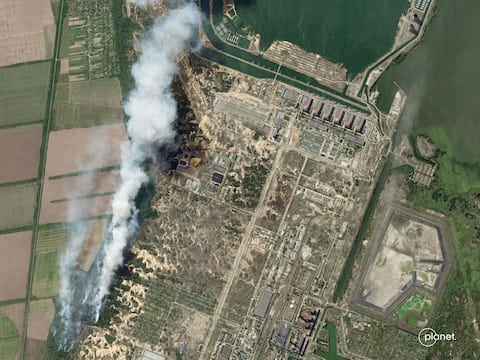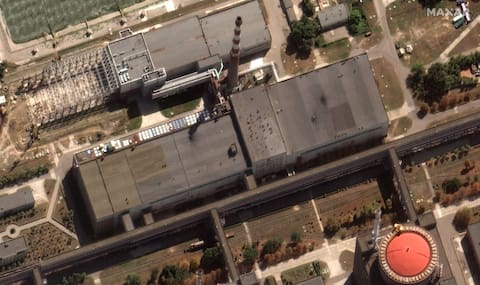
A counteroffensive by Ukrainian forces and heavy Russian bombardment left southern Ukraine at the center of conflict overnight from Monday to Tuesday, while UN experts are expected at the Zaporizhia nuclear power plant.
• Read more: Ukraine: IAEA mission expected this week in Zaporizhia
The International Atomic Energy Agency (IAEA) is tasked with inspecting the largest plant in Europe, occupied by the Russians since early March and at the center of all the tensions.
The Ukrainian counteroffensive is essentially aimed at retaking the city of Kherson – population 280,000 before the conflict – which fell into Russian hands at the start of the war, local officials said.
“Ukrainian armed forces launched their offensive in several areas in the south. We ask residents of Kherson to follow safety instructions: stay close to shelters and stay away from Russian positions,” Yaroslav Yanushevich, head of the regional administration, wrote in a telegram.
“Today there were powerful artillery attacks on enemy positions along the border of the occupied Kherson region (…). This is the announcement we have been waiting for since the spring: this is the beginning of the end of the occupation of the Kherson region”, located at the gates of Crimea, which was annexed by Moscow in March 2014, announced on his part. Ukrainian TV Sergiy Klan, a local MP.
He assured the Ukrainian military of an “advantage” in the south after a series of strikes in recent weeks on bridges and dams on the Dnieper, a major river that crosses this part of Ukraine, aimed at disrupting the logistics of Russian troops.
The Ukrainian military group “Kakovka” said it had observed a detachment of Russian-backed separatist militia retreating from its positions in the region.
According to Moscow, the attack “failed”.
Russia, for its part, said it had repelled Ukrainian “attack attempts” in the Kherson and Mykolayiv regions of southern Ukraine.
“During the day (…), Ukrainian troops attempted an offensive in three directions in the Mykolaiv and Kherson regions,” the Russian Defense Ministry announced, adding that it “failed miserably” and that the Ukrainians “suffered heavy losses.” .
The spokeswoman for the “Southern” command of the Ukrainian army, Natalya Koumeniuk, had earlier said that Kiev forces were attacking this front “from several directions” in order to push the Russians back to the left bank of the Dnieper.
During the night from Monday to Tuesday, the command posted on Facebook that the situation was “tense” in its area of operations, stressing that “the enemy attacked our positions five times, but all of them failed.”
He noted the “massive daylight bombardment” of Mikolaiv by the Russians with sixteen S-300 anti-aircraft missiles, which caused “particularly significant” damage to residential buildings and transport infrastructure. According to this source, two civilians were killed and 24 injured.
He added that two missiles fell in the evening in the Bachdansky area and damaged houses, but there were no casualties at this stage.
All this information cannot be verified from independent sources.
“Ukraine will take back what belongs to it, and eventually everything – Kharkiv, Luhansk, Donetsk, Zaporizhia, Kherson, Crimea, the Black Sea and the Sea of Azov (…)”, hammered Ukrainian President Volodymyr Zelensky in his daily evening news.
Nor did the Russian bombardment stop along the front line stretching from north to south.
Local authorities specifically noted strikes in Kharkiv (northeast), Dnipropetrovsk (center), and Mykolaiv regions where one person was killed.
“It shook, everyone ran outside,” Olga, a 40-year-old resident of Mykolaiv, told AFP after the missile and rocket landed in her neighborhood.
“It happened in an instant, in an instant, it was dark in the house,” testified one of his neighbors, Oleksandre Choula (66), whose wife was now killed.
An IAEA mission in Ukraine
The IAEA has announced that it will send a mission to the Zaporizhia power plant in southern Ukraine, led by its director general, Raphael Grozy.
He is scheduled to visit these facilities “this weekend”.
Mr. Croci had been asking for months to be able to go there, warning of a “real risk of nuclear catastrophe” after a series of bombings.
In a statement on Monday, the G7 nations, “deeply concerned” by the risk of a nuclear accident in Zaporizhia, called for full freedom of movement for international experts.
“Russia must ensure safe and unfettered access” to the IAEA panel, a US official said, adding that the “safest” option was a “controlled” shutdown of the reactors.
Russia was accused of deploying artillery pieces at the site of the power plant to shell its military positions, Kremlin spokesman Dmitry Peskov said on the same day Russia deemed the inspection “necessary”.
Nevertheless, Ukrainian operator Energoatom said Russian soldiers “put pressure on the plant’s employees to prevent them from revealing evidence of the occupier’s crimes.”
“Ukrainian sovereignty over this plant must not be denied,” said French President Emmanuel Macron.
Zaporijjia City Hall said it has been distributing iodine tablets to people within a 50km radius around the plant since August 23, to be taken in case of a radiation warning.
On Monday, city residents were bracing for the worst.
“You know, we experienced the Chernobyl accident, the threat was already very high, but we survived, thank God. Today, the threat is 100%,” commented the retired Katerina.






More Stories
More than 200 former Republican aides back Kamala Harris | US Election 2024
An investigation into the ill-treatment of the Lev Tahor sect in Guatemala
Brossard is suspected by the US of supporting Russia’s war effort